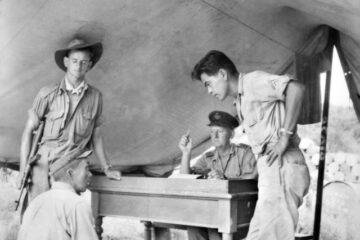Introduction
Very few people in Indonesia, Australia and the Netherlands know that during WWII many Indonesians fought on the side of the Allies. And nobody there knows the estimate of 4 million deaths. Because both are not part of Indonesia’s official history and therefore its public memory. The article below explains the disappearance of the 4 million estimate during the 1950s here. 4 million is most likely too high. In the 2nd article below Pierre estimates excess mortality of Indonesians during 1942-45, particularly during the 1944-45 famine in Java, as just over 1.8 million people.
The outrageous number of victims estimated by Pierre are all Indonesians. It excludes Chinese and European people in Java, because it is based on estimates of birth and mortality rates among ethnic Indonesians. And the 1944-45 famine was caused by the Japanese authorities in Java, which Indonesian nationalists knowing but remaining acquiescent in 1944 and 1945.
While the famine occurred under in Indonesia the relavance here is the colonial NEI Government in exile prepared the humanitarian recovery of Indonesia largely in Australia. And the main architect of the recovery effort was Peter Sitsen, who died in Sydney. The colonial government stockpiled food and medical supplies, as well as other materials, that were ready for shipment to Indonesia as soon as the Allies defeated the Japanese. First in West New Guinea, now known as Papua in Indonesia, and in other parts of East Indonesia in late 1944. During 1944-1945 Netherlands Indies Civil Administration (NICA) officers discovered various instances of human neglect. Not only the many romusha (forced labourers) who they found on various Japanese construction sites in East Indonesia, also among the civilian populations in Balikpapan, Tarakan, Ambon etc. Shipments of supplies from Australia helped to alleviate the situation there relatively quickly.
That was not the case in the areas that remained outside the control of the Allies/NICA and later of the returning colonial government. Famine remained a huge problem in Java after August 1945, particularly during the 1945-46 lean season prior to the 1946 rice harvest, specifically in Central Java and in Madura. Large numbers of famished people arrived from Madura in Surabaya and from Central Java in Semarang. Many others must have perished. Even a year later, during the first Dutch military action in July 1947, the military and colonial government representatives continued to uncover famine areas. During 1946-1947, the food shortage was aggravated by the fact that the colonial government could not ship food supplies from Australia to the famine areas. Two reasons: (a) the government of the Republic denied that there was a problem and disallowed the distribution of relief supplies, and (b) Dutch ships could not ship food supplies that were still stored in Australia due to the union boycotts in Australian ports.
Missing millions: Java’s 1944–45 famine in Indonesia’s historiography – Abstract
Published online by Cambridge University Press: 12 April 2024
Author: Pierre van der Eng
This study examines the largely overlooked 1944–45 famine in Java and explores why its victims remain absent from Indonesia’s public memory and historiography. The limited availability of direct information, partly due to Japanese censorship, obscured the famine’s scale and causes. Yet, reports of severe food shortages reached the outside world in 1944 and 1945 through testimonies from people who escaped Java and romusha laborers rescued by Allied forces in West Papua and other regions. Representatives of the Nederlands East Indies Government in Exile, based in Brisbane, Australia, gathered these accounts, which formed the basis of confidential reports in early 1945 and subsequent media summaries describing Java’s food situation as “desperate.”
Following Japan’s surrender on 15 August 1945, information on Java’s food crisis emerged slowly as government officials began returning to urban centers like Jakarta and Surabaya. An extensive relief plan aimed to distribute stockpiled food and supplies across Java, yet political tensions limited its reach to eastern Indonesia and urban enclaves. Anticipating worsening food shortages before the main harvest in April–May 1946, the NEI Director of Economic Affairs, Jacob E. van Hoogstraten, reported a famine toll of four million deaths from starvation
and disease—an estimate that would echo in public discourse but remains debated in historiography. This article revisits the famine’s historiographical absence and highlights the political and logistical barriers to its recognition and relief.
Missing millions: Java’s 1944–45 famine in Indonesia’s historiography
Mortality from the 1944–1945 famine in Java, Indonesia – Abstract
Author: Pierre van der Eng
This article examines the human toll of the 1944–1945 famine in Java, Indonesia’s main island. It estimates birth and death rates for the Indonesian population in Java during 1941–1951. Using the net population loss method, the article approximates a net loss of 3.3 million people during the 1942–1945 Japanese occupation period. This includes 1.8 million excess deaths; 0.7 million during 1944 and 1.1 million during 1945. The remainder are 1.4 million missing births in 1944 and 1945, associated with the malnutrition of women of childbearing ages and physical separation of wives from husbands recruited by Japanese authorities for forced labour.


